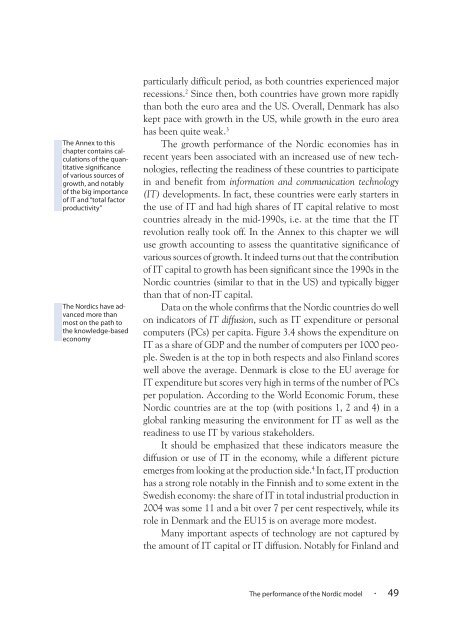The Nordic Model - Embracing globalization and sharing risks
The Nordic Model - Embracing globalization and sharing risks
The Nordic Model - Embracing globalization and sharing risks
Create successful ePaper yourself
Turn your PDF publications into a flip-book with our unique Google optimized e-Paper software.
<strong>The</strong> Annex to this<br />
chapter contains calculations<br />
of the quantitative<br />
significance<br />
of various sources of<br />
growth, <strong>and</strong> notably<br />
of the big importance<br />
of IT <strong>and</strong> “total factor<br />
productivity”<br />
<strong>The</strong> <strong>Nordic</strong>s have advanced<br />
more than<br />
most on the path to<br />
the knowledge-based<br />
economy<br />
particularly difficult period, as both countries experienced major<br />
recessions. 2 Since then, both countries have grown more rapidly<br />
than both the euro area <strong>and</strong> the US. Overall, Denmark has also<br />
kept pace with growth in the US, while growth in the euro area<br />
has been quite weak. 3<br />
<strong>The</strong> growth performance of the <strong>Nordic</strong> economies has in<br />
recent years been associated with an increased use of new technologies,<br />
reflecting the readiness of these countries to participate<br />
in <strong>and</strong> benefit from information <strong>and</strong> communication technology<br />
(IT) developments. In fact, these countries were early starters in<br />
the use of IT <strong>and</strong> had high shares of IT capital relative to most<br />
countries already in the mid-1990s, i.e. at the time that the IT<br />
revolution really took off. In the Annex to this chapter we will<br />
use growth accounting to assess the quantitative significance of<br />
various sources of growth. It indeed turns out that the contribution<br />
of IT capital to growth has been significant since the 1990s in the<br />
<strong>Nordic</strong> countries (similar to that in the US) <strong>and</strong> typically bigger<br />
than that of non-IT capital.<br />
Data on the whole confirms that the <strong>Nordic</strong> countries do well<br />
on indicators of IT diffusion, such as IT expenditure or personal<br />
computers (PCs) per capita. Figure 3.4 shows the expenditure on<br />
IT as a share of GDP <strong>and</strong> the number of computers per 1000 people.<br />
Sweden is at the top in both respects <strong>and</strong> also Finl<strong>and</strong> scores<br />
well above the average. Denmark is close to the EU average for<br />
IT expenditure but scores very high in terms of the number of PCs<br />
per population. According to the World Economic Forum, these<br />
<strong>Nordic</strong> countries are at the top (with positions 1, 2 <strong>and</strong> 4) in a<br />
global ranking measuring the environment for IT as well as the<br />
readiness to use IT by various stakeholders.<br />
It should be emphasized that these indicators measure the<br />
diffusion or use of IT in the economy, while a different picture<br />
emerges from looking at the production side. 4 In fact, IT production<br />
has a strong role notably in the Finnish <strong>and</strong> to some extent in the<br />
Swedish economy: the share of IT in total industrial production in<br />
2004 was some 11 <strong>and</strong> a bit over 7 per cent respectively, while its<br />
role in Denmark <strong>and</strong> the EU15 is on average more modest.<br />
Many important aspects of technology are not captured by<br />
the amount of IT capital or IT diffusion. Notably for Finl<strong>and</strong> <strong>and</strong><br />
<strong>The</strong> performance of the <strong>Nordic</strong> model · 49

















